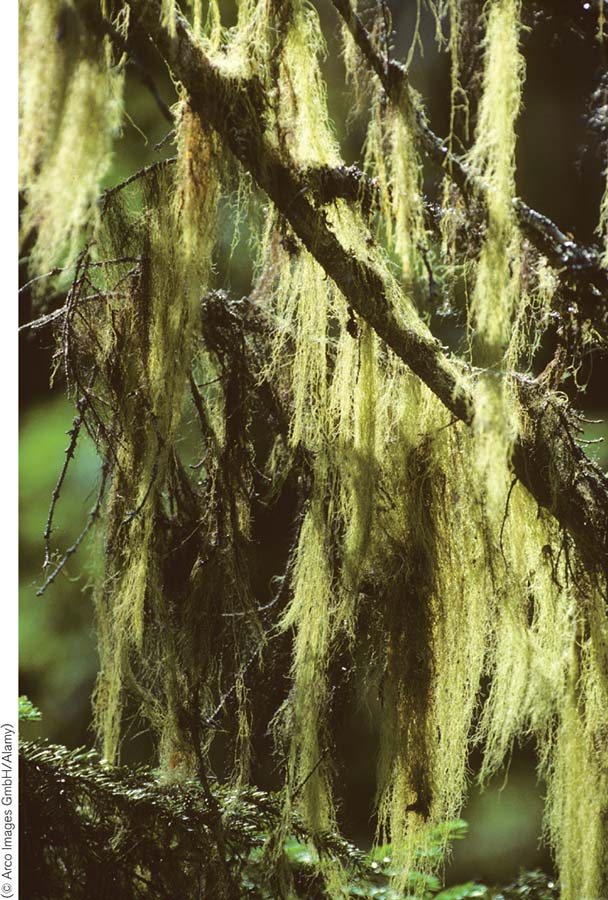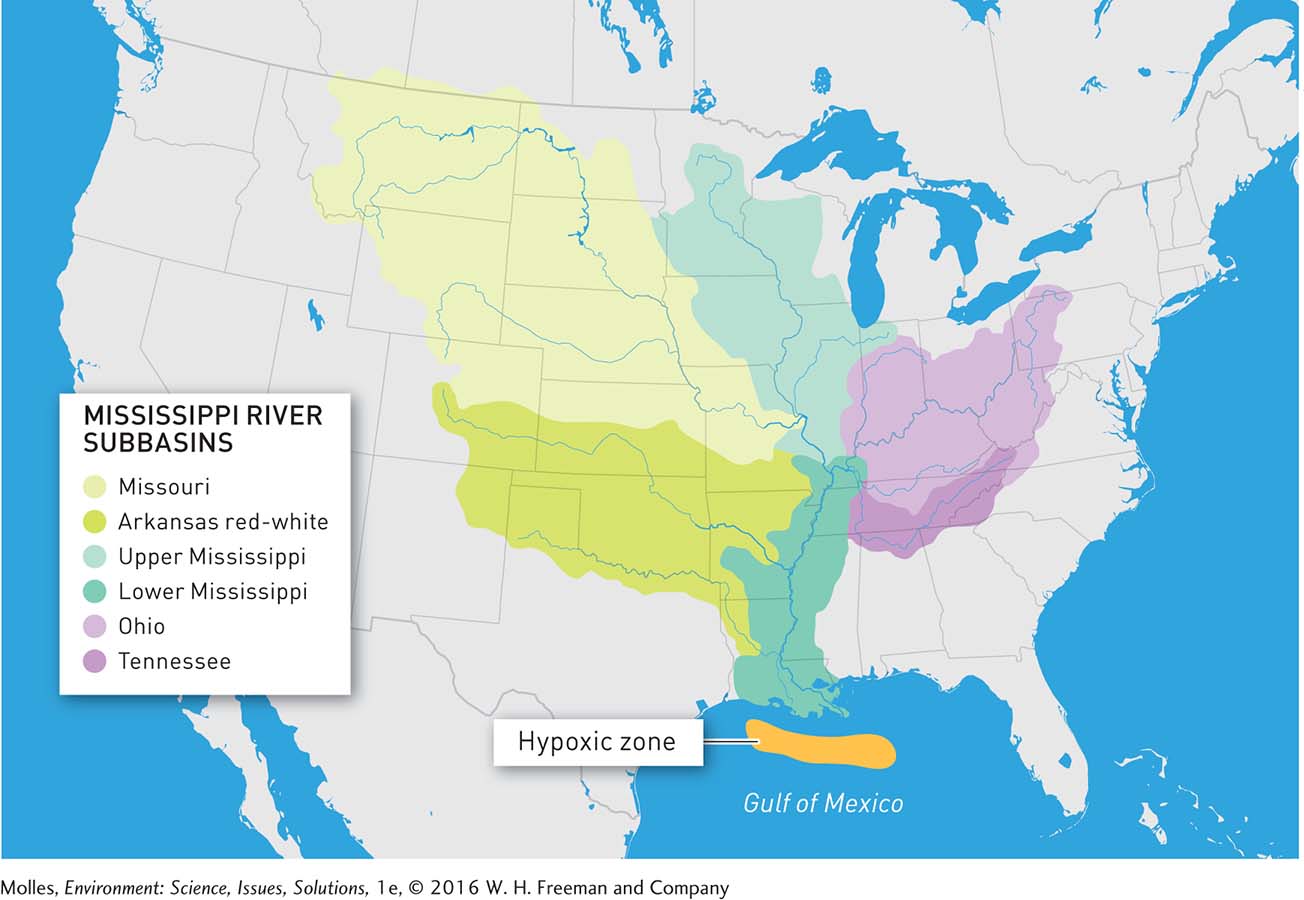13.7 Organic matter and nutrient pollution can disrupt local and distant ecosystems
When too much organic matter and nutrients pollute ecosystems, they can alter their function and harm biodiversity. Around the world, nutrient pollution has been blamed for harmful algal blooms and dead zones in oceans and lakes.
Organic Pollution of Aquatic Ecosystems

In what ways could a substantial reduction in the amount of meat in the U.S. diet—
Concentrated animal feeding operations, or CAFOs, are pens or buildings where livestock, including chickens, cattle, and pigs, are housed and fed to support industrial-
The amount of waste produced by such operations can be staggering. For instance, the 800,000 hogs in the cited example produce more than 1.6 million tons of manure annually, 1.5 times the amount of sanitary waste produced by the 1.5 million people living in Philadelphia, Pennsylvania. Between 1982 and 2002, the number of animals raised in large CAFOs in the United States increased by more than 240%, from 257 million to nearly 900 million. Where the organic wastes from CAFOs are not managed properly, they can severely impact aquatic ecosystems (see Figure 13.5, page 394). Even where organic wastes from CAFOs are well managed, however, they are commonly a significant source of nutrient additions to groundwater and aquatic ecosystems and can be a source of eutrophication.
Nutrient Enrichment and Eutrophication
The industrial production of fertilizers and the burning of fossil fuels have more than doubled the inputs to the global nitrogen cycle since the late 20th century, causing cultural eutrophication. The extra nitrogen is either dissolved in water or spewed into the atmosphere as nitrogen oxides and subsequently deposited on soil with rain or snowfall or through dry deposition as a salt or gas. For instance, atmospheric nitrogen deposition in the San Bernardino Mountains east of Los Angeles has increased 14 times over the last 75 years (Figure 13.27).


How are the effects of excess addition of nutrients to an ecosystem analogous to the dose–
Nitrogen enrichment of terrestrial ecosystems has shifted the composition and function of ecosystems. Some organisms, such as lichens and mycorrhizal fungi, are particularly sensitive and die off with increased nitrogen deposition (Figure 13.28). For example, between 1958 and 1987, the number of species of mycorrhizal fungi in soil samples collected in the San Dimas Experimental Forest in the Los Angeles Basin decreased from 29 to 7, a loss of 76% of the species in the community. Changes in species composition can also result in negative effects on ecosystem function. For instance, in some arid ecosystems in California, nitrogen deposition has fostered the increased biomass of nutrient-

Dead Zones in Coastal Areas

Are coastal “dead zones” actually dead, that is, entirely devoid of life, or is the term misleading?
The excess nutrients deposited on terrestrial ecosystems often find their way to coastal waters, with disastrous consequences. Much of the phosphorus, nitrogen, and other nutrients that humans have added to the biosphere eventually end up in the rivers and streams that drain the continents. Consequently, these nutrients contribute to the cultural eutrophication of coastal ecosystems, where they stimulate high levels of primary production. As in eutrophic lakes, high levels of decomposition follow high levels of biomass production in coastal ecosystems, which depletes dissolved oxygen levels—
408

Think About It
How is the problem of ecosystem eutrophication an example of a Tragedy of the Commons (see Chapter 2)?
Compare cultural eutrophication of lakes with the formation of “dead zones” in coastal regions (see Figure 13.8, page 396).
How does the fact that much of the eutrophication of both aquatic and terrestrial ecosystems results from nonpoint sources of pollution complicate developing a solution to the problem?
409
13.4–13.7 Issues: Summary
The World Health Organization estimates that more than 7 million people die of air pollution each year. Other damages caused by pollution come with real economic costs related to deterioration of infrastructure, reduced agricultural or forest productivity, loss of valuable fisheries, and impaired human health and longevity.
The impacts of acid rain have grown with increased burning of fossil fuels, particularly in highly industrialized regions. Damage to terrestrial vegetation, especially to forests in North America and Europe, was one of the first recognized impacts of acid rain, followed by devastated stream and lake ecosystems across vast areas.
The accumulation of persistent organic pollutants, such as DDT and PCBs, and heavy metals in soils and sediments—
Concentrated animal feeding operations, or CAFOs, have become a particular source of pollution concerns in the United States. Adding excessive nutrients to ecosystems leads to cultural eutrophication, which generally results in excessive algal or plant production, depletion of dissolved oxygen, and loss of biodiversity in aquatic ecosystems. Eutrophication of terrestrial ecosystems can change the species composition and reduce the biodiversity of those ecosystems. Excessive nutrient inputs to coastal ecosystems have produced coastal “dead zones” around the world.